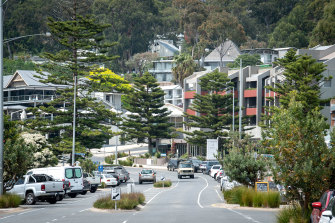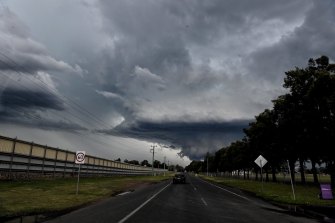Rising regional populations a challenge for bushfire protection
Fast-growing communities living beside bushland on the Great Ocean Road, Daylesford and outskirts of Bendigo are among the groups of tree-changers causing fire management headaches for Forest Fire Management Victoria.
The state’s forest fire agency has conducted planned burns and fuel management on three-quarters of the land earmarked for action, but the exodus of Melburnians to those areas has placed greater strain on the resources needed to protect these communities from disastrous blazes.
Victoria is unlikely to face fires of the scale of Black Summer, but authorities remain on alert despite milder forecast conditions. Credit:Darrian Traynor/Getty Images
The latest report from the agency showed mild conditions had allowed it to complete planned burns on almost 133,195 hectares of land, while 18,888 was treated by other means, including slashing and mowing.
A total of 200,000 hectares was identified as suitable for fuel management in 2020/21.
The planned burning and other bushfire management strategies helped bring down the state’s bushfire risk to 63 per cent, compared to a statewide target of 70 per cent or below.
Forest Fire Management chief fire officer Chris Hardiman said many of the planned burns were conducted in high priority areas – often close to where people live.
“These are the burns that are really challenging and difficult to do hard up against community, critical infrastructure and those that add most to the risk reduction value,” he said.
But this task is likely to become increasingly difficult, as metropolitan migration to regional Victoria places greater strain on risk mitigation resources and firefighters.
Figures from the Australian Bureau of Statistics showed 4800 people left Melbourne for another part of the state in the March quarter alone.
Planned burns in coastal communities are becoming increasingly difficult with a growing population. Credit:Eddie Jim
“For us, it creates increased complexity in delivering planned burning when there is private property adjacent to the forested areas,” Mr Hardiman said.
“We have to put more resources into ensuring those private interests are protected. But the people of Victoria have chosen to live in these places.”
Surf Coast Shire mayor Libby Stapleton said the population appeared to be increasing in coastal towns across the municipality with many people making holiday homes their permanent residence.
Other areas such as Torquay and inland communities have also become more populous in recent years.
“The Surf Coast has been earmarked as a place of growth. We know growth is coming,” Cr Stapleton said. “In terms of how rapidly that happens is probably a bit unknown.”
La Nina weather conditions have brought wet weather to Victoria and eased the risk of a major bushfire like the Black Summer fires. Credit:Nick Moir
Monash University bushfire resilience expert Caroline Spencer said houses in some fire-prone areas were “selling like hotcakes”, but newcomers needed to understand the risks they faced.
She said some of those people may not be aware of the work involved in planning for fires and recovering from their aftermath.
“Recovery takes an enormous amount of time and people aren’t prepared for that,” Dr Spencer said.
Dr Spencer, who lives in the extreme bushfire zone of Guys Hill on Melbourne’s outskirts, has helped create an online risk mitigation tool for her community that provides information about the most effective strategies for protection from bushfires, including fuel and vegetation management and weed control.
A La Nina weather pattern creating wet conditions has resulted in a mild outlook for this fire season.
But Mr Hardiman said there would still be about 1000 fires with authorities watching for grass and crop fires in early summer.
“We can confidently think that we’re not going to have any large-scale bushfires through to post-Christmas, and then we’ll re-evaluate and look at what the weather is doing,” he said.
An expected increase in Victorians holidaying locally also remains a concern for authorities this summer, as people venture further into remote locations.
Mr Hardiman said a short burst of hot, dry and windy weather may still result in extremely dangerous fires this season.
“We could have a short duration – two or three day bushfire – that could have really devastating consequences and cost the lives of Victorians.
“Even though it’s a positive outlook for bushfires it doesn’t take much for that to change in our state.”
Fascinating answers to perplexing questions delivered to your inbox every week. Sign up to get our new Explainer newsletter here.
Most Viewed in National
From our partners
Source: Read Full Article


